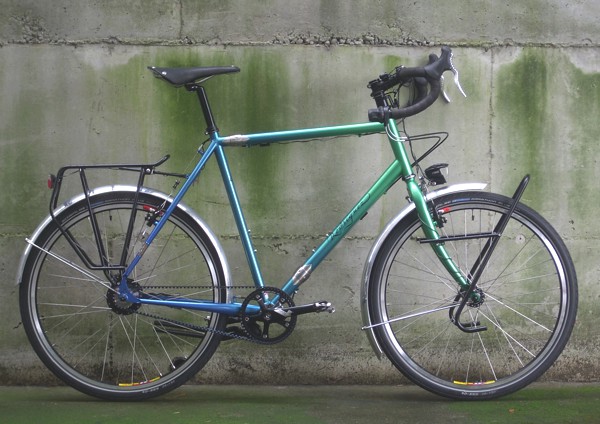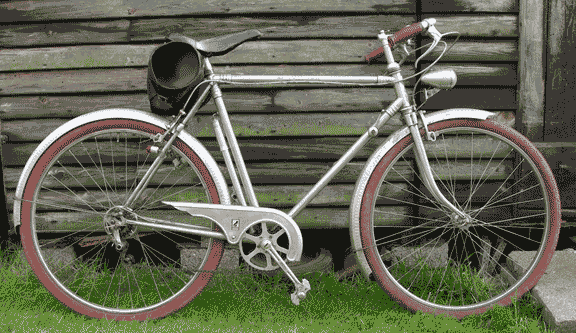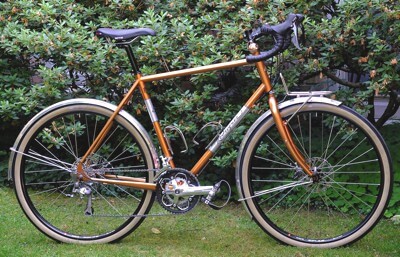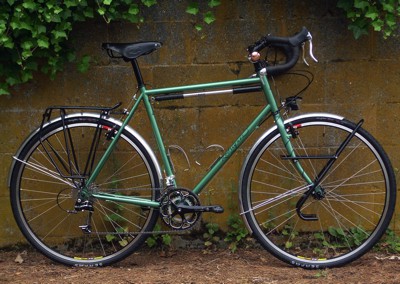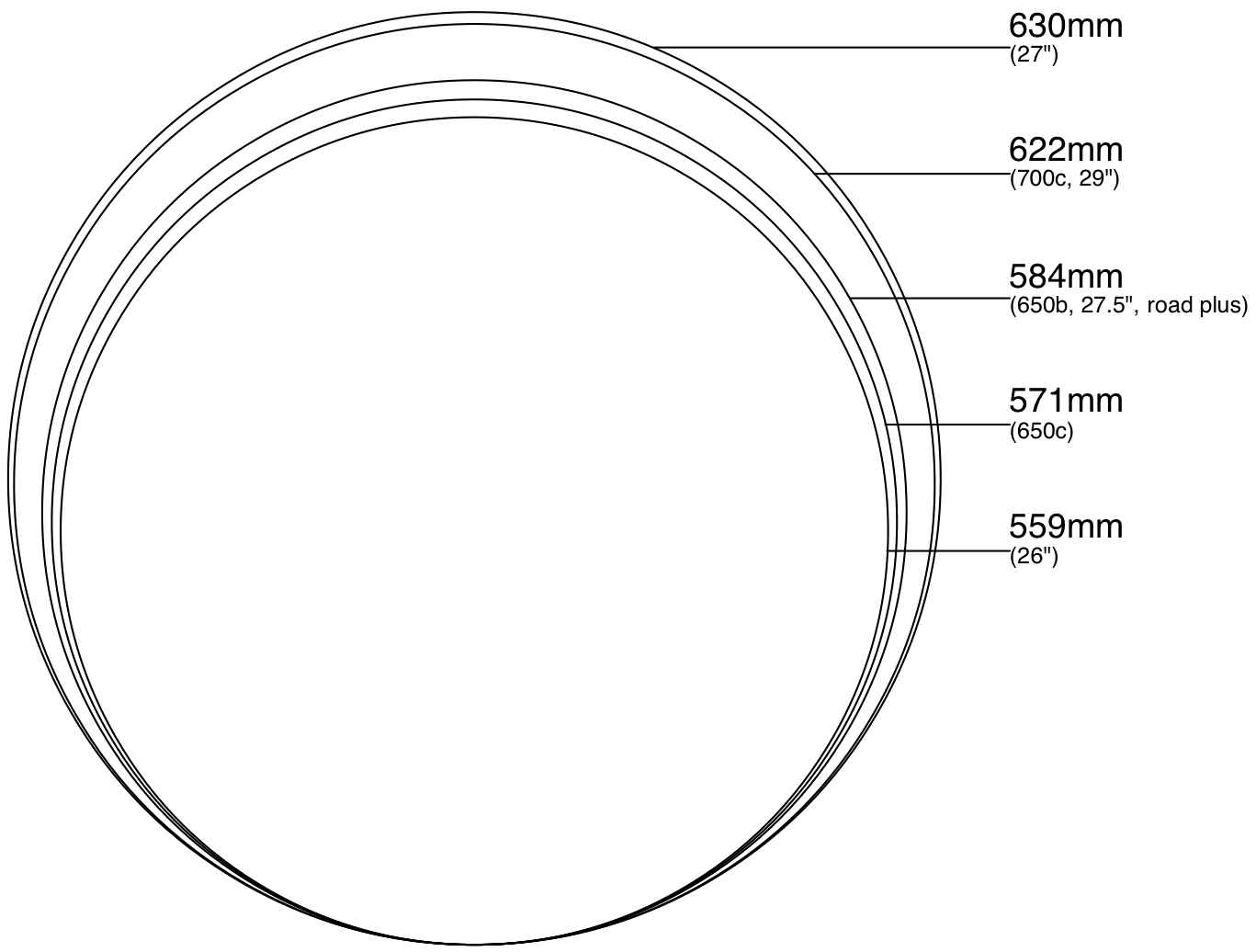
What Wheel Size is Best for a Bicycle?
Everything you need to know about 700c, 29'r, 650b, 650c, 27.5", 27", Road Plus, 26", and Cruiser sized bicycle wheels
Related articles:
Tire Size and Toe Overlap
The effect of Wheel Size on Speed
World's Fastest Bicycles
and the wheel sizes they use
Are Smaller Wheels Slower?
Smaller Wheels for Smaller Bicycles
Are Bigger Wheels Faster?
Big Fast Wheels
Tire Size and Toe Overlap
The effect of Wheel Size on Speed
World's Fastest Bicycles
and the wheel sizes they use
Are Smaller Wheels Slower?
Smaller Wheels for Smaller Bicycles
Are Bigger Wheels Faster?
Big Fast Wheels
So, this year it's time for a quick article on the current state of the bicycle wheel/tire size and some myth busting as it relates to them. We'll talk about 700c (or 29'r as it is referred to in the mountain bike world). 650b (or 27.5 in the mountain bike world), and 26" (or 26" as referred to in the mountain bike world ;-) These are all common sizes that people like to use for standard road, touring, gravel grinding, and tandem bicycles. There are limitations and benefits to all of them as you'll see.
Who is the article for?
This article is written for the person who wants to run wide tires (and possibly fenders) on their road, touring or gravel bike. This is very common in our current market, and design considerations must be made for proper handling, comfort, and safety of the rider. When I say wider tires, I mean tires that are wider than 38c (or 1 1/2"). In 2018, people are running tires 2" wide or even wider on their road and gravel bikes.
There is NO magic wheel size
What makes a wheel size good or bad is not what a magazine article, or salesperson says about it. You need the wheel size that works best for your fit, and the purpose for the bicycle. Convenience as well as rim and tire availability should play a role in your choice as well. Where are you travelling, and will you be able to easily get tires or wheels if needed? I would love it if the industry could put their bias aside and listen to what their customers are asking for before recommending anything about a bicycle. Wheel size should be a part of the bicycle design....a design that considers the rider's fit, comfort, convenience, or any other characteristics that are really important.
Quick technical term: There's a lot of confusion around some wheel sizes because our industry refers to them in many different ways. Our aim is to educate our customers so they can make their decisions on facts rather than current industry hype.
The Term is - Bead Seat Diameter - This is how the real size of a wheel is determined. This is the diameter, in millimeters, of the part of the tire where it seats (or connects) onto the rim. This is the term that we use to order the proper tire for a rim size. I think as you read through this article, you will see that there are not as many popular wheel sizes as it seems.
On to the wheel sizes and their benefits. We'll do them in order of Bead Seat Diameter from smallest to largest.
Let's start with 26" wheels (559mm Bead Seat Diameter)
This is the most common size of bicycle wheel on the planet. They used to be known as 'cruiser' or 'balloon tire' sized wheels. If you are planning to take your bicycle to any 2nd or 3rd world country, then I strongly suggest 26" wheels. I've had customers afraid of this very common wheel size because mountain bikes have evolved to other wheel sizes. For some reason, I don't know if they read something or a salesperson told them something, but there are those who have been led to believe that 26" wheels are obsolete. Well, let me assure you that this wheel size is safe and sound.
Good reasons for 26":
For decades now, we've built touring bicycles and tandems for this 26" size. There are a lot of benefits to 26". I ride them myself on my tandem, and always have.
Gravel Grinding and Wide tires: There are a lot of wide tires available for the 26" size. Mountain bikes were built almost exclusively in this size until recently, so there are literally millions of bicycles out there using this size.
Strength: Tandem and heavy duty touring bikes need really strong wheels. This size was a great strength alternative to 700c. In tandem building for instance, we consider a 36 spoke wheel in the 26" size to be as strong as a 700c wheel that has 48 spokes. Because of the smaller diameter, the spokes end up almost as close together as the 700c with 48 spokes. This allowed us to save some weight in tandems and heavy loaded touring bikes without sacrificing strength, and at the same time give the customer a wheel that was easier to have repaired all over the world. That brings me to the next reason....
Availability: 26" has been the most reliably available size around the world for several years. That goes for tires, tubes and rims as well. As far as tandems are concerned, being able to run a 36 spoke wheel as opposed to a 48 spoke wheel meant that the hubs were also much more available anywhere they traveled too.
Much better for Travel bike: Here's the big one. For a bike that will be packed into a 26" x 26" suitcase for certified airline 'non-oversized' travel, 26" provides the most realistic option. Yes, a 700c wheel can go into the case that size, but not with the tires on, and you have to sacrifice packing a lot of your other accessories. Most touring cyclists prefer to be able to pack their racks into the case with the bike. 26" wheels allow for that.
Toe Overlap: Nobody wants to hit their foot with their wheel when they turn. I have sold many bikes to people that ended up with a custom bike from 'another builder' that had this problem. You see, if you want really wide tires, then the diameter of your wheel increases along with that width. In the last several years, people have wanted wider and wider tires, and the ability to run fenders. This just is not practical for most people on 700c wheels (and is the reason that 650b has made a come back). A 700 x 25c tire is almost the same diameter as a 26" x 2" tire. The 26" wheel size enables most people to run really wide tires and still have plenty of clearance for fenders and their foot when they turn. If you'd like to view some photo galleries of Rodriguez bikes with 26" wheels, click here.
Now 650b...or 27.5"...or Road Plus...or whatever the current buzz word is
These are actually all the same size. The bead seat is 584mm. They are all what used to be called 650b. Like I always say, there's nothing new in the bike industry. This size once was common, mostly in Europe, but went obsolete somewhere in the 1960's. They are making a comeback because the industry has discovered something that we at Rodriguez have been designing around for decades. The fact that bigger, fatter tires need smaller rim diameters (or people hit their feet when they turn). For marketing reasons, the industry feels the need to name them something that sounds new and different...don't ask me why. But, it does cause a lot of confusion for some customers. I find myself explaining this to at least a couple of people each week.
650b is very close to the 26" wheel size, and to look at a road bike with 650b wheels next to a road bike with 26" wheels, one would assume they had the same wheel size, but they are different. Until a few years ago there were very few tires and rims available for 650b size so 26" was always the 'fat tire' recommendation. That's changing since the mountain bike world adopted this size as it's current standard a few years ago. There's several 650b road bike tire options (Road Plus) coming on line as well.
Good reasons for 650b:
I'm in support of anything that helps us make a bicycle work better for a customer. After decades of losing sales just by recommending a smaller wheel size to a customer, now here's an option that I can recommend that folks seem enthusiastic about. People that don't want to go all the way down to the 26" size, but realize that 700c is not optimal may find that the 650b size is for them.
Gravel Grinding and Wide tires: Because this has really become the 'new' mountain bike size (27.5"), there are a lot of stout mountain rims and wide off road tires available in this size. This has attracted a lot of our gravel grinding customers to this size.
Because 650b is quite a bit smaller diameter than 700c, wide tires and fenders will clear a lot more riders feet than the 700c will. It's still not optimal for everyone, but it's a nice 'in-between' for a lot average and taller riders.
Strength: All other variables being equal, a smaller wheel circumference always results in a stronger wheel. 650b, being smaller than 700c, means that the mountain bike industry can embrace this size as stronger and so can the heavy duty touring cyclist. If you'd like to look at some image galleries of Rodriguez bicycles that have 650b (and 650c) wheels, click here.
700c or 29'r wheels - (622mm Bead Seat Diameter)
This is the wheel size that has been standard for most road bikes since the 1980's. It replaced the slightly larger 27" (630mm bead seat diameter). See how it gets confusing? How can 27" wheels be bigger than 27.5" or even 29"? I'll explain that in the summary. For now, back to the current size at hand....700c.
For years this was the main size for road bikes, and it was very, very difficult to convince someone that they would be much better off with a smaller wheel size for any reason. So, we, like a lot of other builders, built a lot of 700c bikes for people that really would've been much better off with a 26" or 650b wheel. Fortunately, those days seem to be coming to an end. But 700c still has a solid place in the industry, and I ride them everyday myself on my commuter bike as well as on my Rodriguez Outlaw. It is my preferred size for those bikes and my height. If I wanted to run really wide tires, I would run smaller wheels.
700c will always have a place in the road bike industry. It is quickly disappearing as a touring bike size, but I've always thought that a smaller wheel size was better for touring bikes anyway. 700c will remain the race and traditional road bike standard for people taller than about 5' 5". For folks under that height, they have the 650c size (571 bead seat), 26", and who knows, maybe some good race options in 650b.
For a short time, the 700c wheel size became the standard mountain bike wheel size. The industry re-labeled the 700c wheel mountain bike size as 29", or 29'r because with a really wide tire it was 29" in diameter. During this period, it was difficult, if not impossible to sell a mountain bike with anything but 29" wheels. But, as consumers discovered that large wheels had many disadvantages (like a dangerous lack of toe clearance for one), the industry realized that 700c wheels were actually too big for almost all but the tallest off-road riders. So, they decided that they should move to a smaller wheel size. Why not 26"? I don't know, but I welcome the 650b era of the mountain bike. Slightly larger than 26", and significantly smaller than 700c, the 650b seems to be getting a huge acceptance in the off-road bike crowd.
The Wrap-up
So why all of the label confusion? - Well, it all comes down to how the industry wants to market a wheel/tire size to the consumer. When they refer to 27.5" or 29", they are referring to the diameter with a specific tire width to be used that will result in an overall wheel diameter of that measurement. Since tire width also affects the tires diameter when inflated, every different width, even with the same bead seat, is a different diameter.
Below is a table showing approx. wheel diameters with some tire widths that are easily available for various bead seat diameters. To the left of the table is an illustration representing the actual wheel bead seat diameters. I'm only listing the sizes that I mention in this article. Note that only 26" and 700c have good selections of tire widths available. Notice how tire width affects overall diameter.
| Actual diameters with different 'available' tire widths | |||||||
| 23c | 25c | 28c | 32c | 35c | 47c | 54c | 7/8" | 1" | 1 1/8" | 1 1/4" | 1 3/8" | 1.9" | 2.1" |
|---|---|---|---|---|---|---|---|
| 26" (559) | n/a | 24" | 24.3" | 24.8" | 25" | 25.75" | 26.5" |
| 650c (571) | 24.4" | 24.5" | 24.7" | n/a | n/a | n/a | n/a |
|
650b
(584) | n/a | n/a | n/a | n/a | 26" | 26.6" | 27.3" |
|
700c
(622) | 26.3" | 26.5" | 26.7" | 27" | 27.4" | 28.2" | 29" |
| 27" (630) | n/a | n/a | 27" | 27.4" | n/a | n/a | n/a |
It doesn't really make sense to call a 650b with narrow tires 27.5", so it gets re-labeled 'road plus', even though it's exactly the same rim size. It would create a lot less confusion if we just called everything by it's bead seat diameter, but we don't.
Marketing - Make no mistake, there is a lot of marketing going on out there. Having the newest thing is important to a lot of folks, and marketing departments know that. Saying something like "we're bringin' back the decades old standard of 650b for your new mountain bike" doesn't sound as good as "get the new 27.5" mountain standard" does it? Also, trying to sell someone a smaller wheel size is a reversal of everything the industry has been doing for 2 decades now. Just read my articles over the last 25 years and you'll see what I mean. Obviously 27.5", or 'Road Plus' does not highlight the fact that we are basically returning to something close to 26" wheels by another name ;-) Sure they are a little bit bigger, but not much....see the chart. Had I thought of it, I would've done the same years ago and labeled 26" and 650c something like "touring plus" and "road light". Instead, I wrote article after article trying to educate and inform. Either way, we're thrilled at the acceptance of smaller wheels for better design, and welcome the rest of the bike industry in.
Now you Know - It's all about the Bead Seat Diameter. Since we really have no way of knowing what tire width someone will ultimately be using, the only way to really compare wheel sizes is to use the bead seat diameter. This will remove all of the other variables. Your bead seat diameter sets the tires you have to use, and a narrow tire results in a smaller wheel diameter as a wide tire results in a bigger diameter. It's a lot more important to select a wheel size that has the tire widths available that you might want to use, rather than to choose by 'what everyone else is doing'.
I hope I've cleared up some mysteries for you, but if I've managed to confuse you further, I apologize. I know that all of the terms flying around have confused a lot of people, and even made some people put off buying a new bicycle for fear of making the wrong choice. My advice is to completely ignore anyone who says something like "this is the fastest wheel size", or "oh, that wheel size is becoming obsolete". Set aside other peoples prejudices and consider what you will be doing with your new bike, what widths of tires you want to be able to run, and talk with an experienced bicycle designer here at Rodriguez about the differences. We're happy to build with any wheel size you want, and we are happy to discuss all of the pros and cons of each for your use and fit. We ride all of the above wheel sizes, and have nothing against any of them.
Thanks for reading - Dan - Feb. 2018

